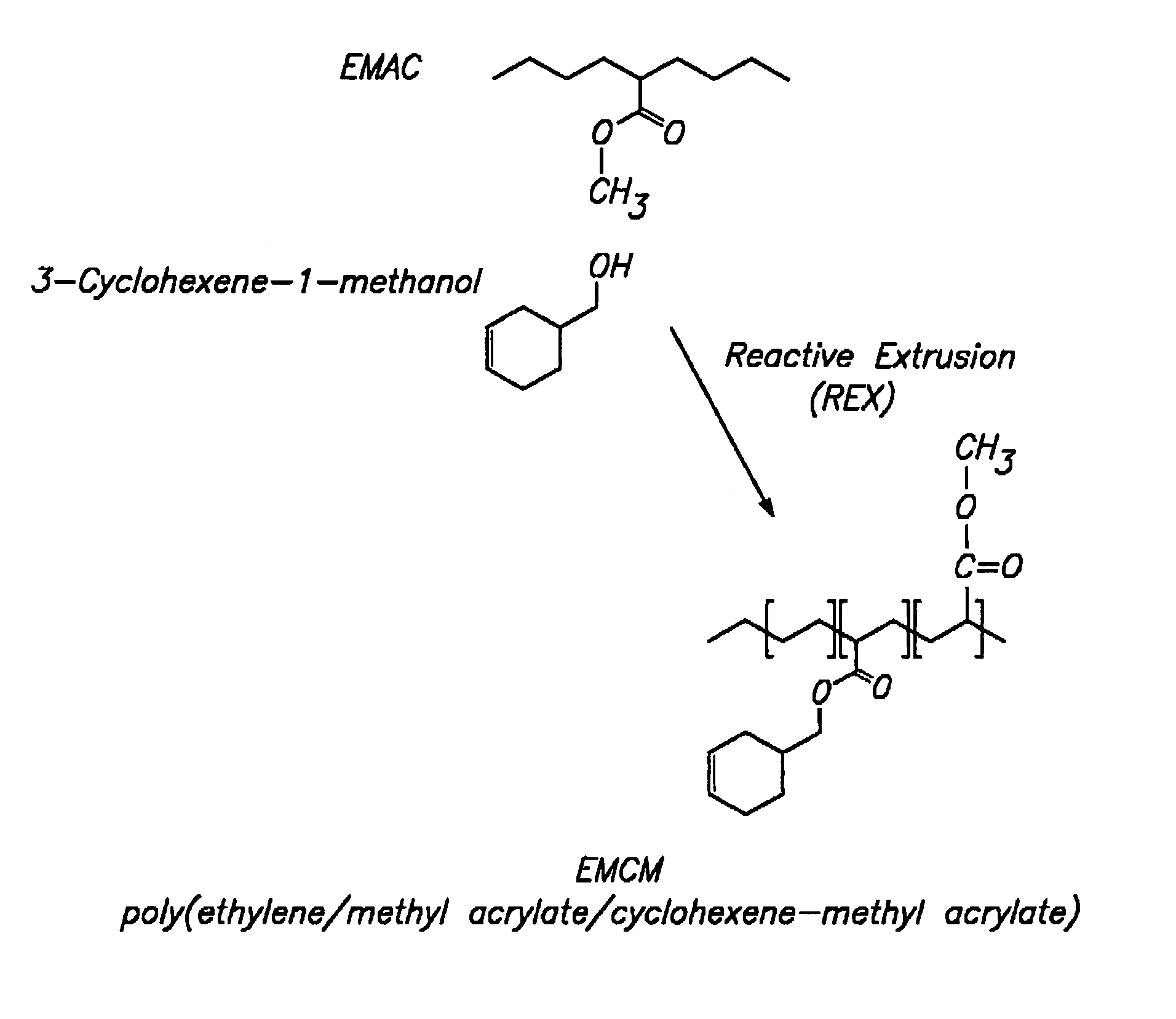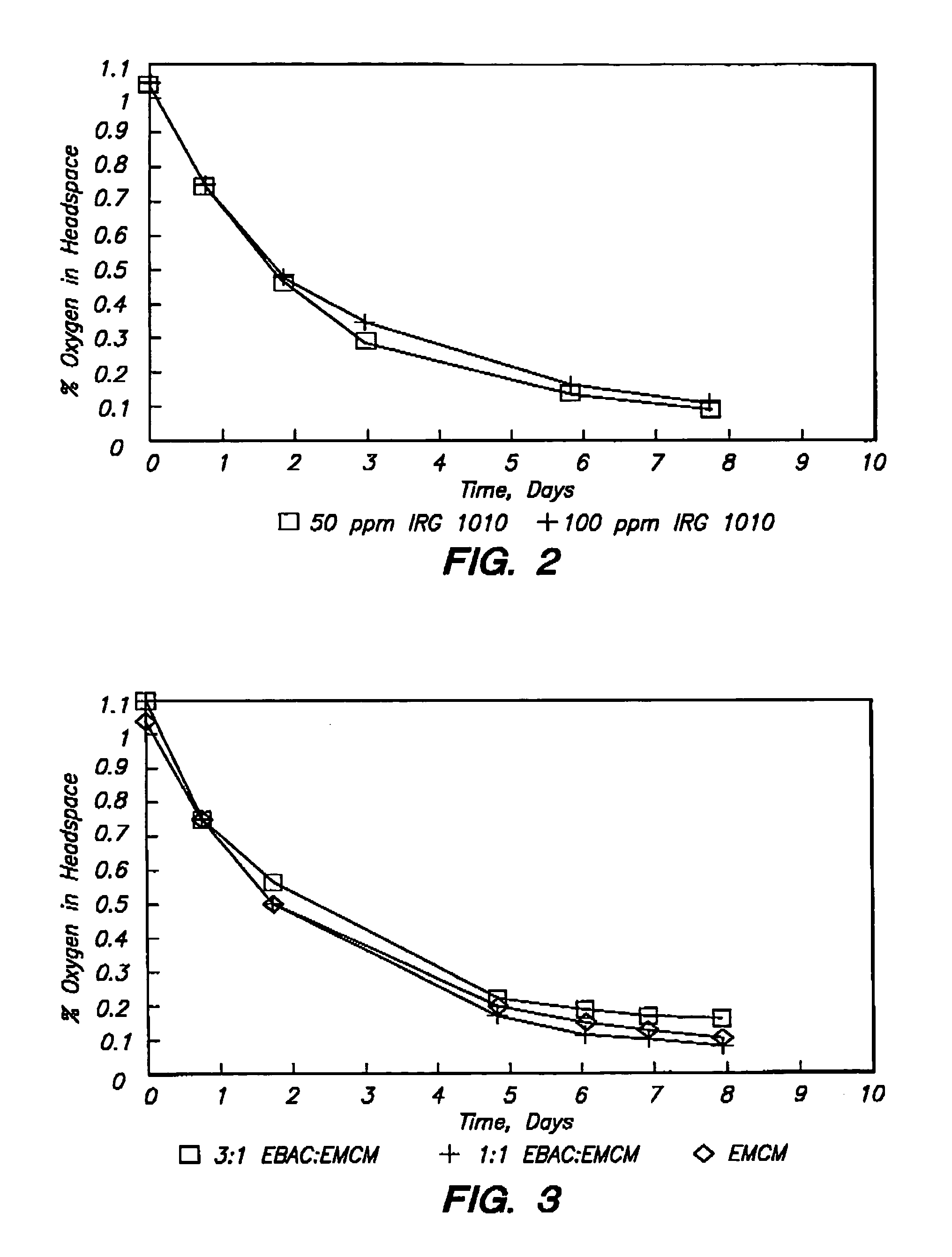Polymer with pendent cyclic olefinic functions for oxygen scavenging packaging
a technology of cyclic olefinic functions and oxygen scavenging, which is applied in the directions of transportation and packaging, other domestic articles, synthetic resin layered products, etc., can solve the problems of reducing the optical transparency of the wall, sachets can present a problem to consumers, and the need for additional packaging operations, so as to improve the initiation of oxygen scavenging.
- Summary
- Abstract
- Description
- Claims
- Application Information
AI Technical Summary
Benefits of technology
Problems solved by technology
Method used
Image
Examples
example 1
Polymer Preparation (C1641-6)
[0130]550 ml of decalin® was placed in a flask. To this was added 350 g of Chevron EMAC SP-2260 which has 24 weight % of methyl acrylate (0.9767 moles of methyl acrylate) and 0.48 g of Irganox®1076 (0.1 mole). The temperature of the mixture was gradually raised while stirring. When the temperature reached approximately 120° C., 127.1 g (0.9767 moles) of 3-methyl-cyclohex-1-ene-4-methanol (97%) was added. When the temperature reached approximately 140° C., 4.8 g of the catalyst Ti(OC2H5)4 was added a portion at a time. The temperature was maintained at 170° C. while stirring. The course of the reaction was observed by subjecting samples of the mixture to NMR at hourly intervals. The percent conversion is given in Table 1 below. After 5 hours of reaction, the mixture was cooled and 400 ml of CHCl3 was added and the mixture was then precipitated by adding it to 4 liters of CH3OH in a Waring blender. The precipitate is filtered and washed with CH3OH and drie...
example 2
Polymer Preparation
[0132]600 ml of decalin was placed in a flask. To this was added 334 grams of Chevron SP-2260 (0.9330 moles of methyl acrylate) and 0.44 g of Irganox® 1010 (0.1% mole). The temperature of the mixture was gradually raised while stirring. When the temperature reached approximately 120° C., 104.6 g (0.93 moles) of cyclohex-1-ene-4-methanol was added. When the temperature reached approximately 140° C., 4.4 g of the catalyst Ti(OC2H5)4 was added a portion at a time. The temperature was maintained at 160° C. while stirring. The course of the reaction was observed by subjecting samples of the mixture to NMR at hourly intervals. The percent conversion is given in Table 2 below. After 3 hours of reaction, the mixture was cooled and 400 ml of CHCl3 was added and the mixture was then precipitated by adding it to 4 liters of CH3OH in a Waring blender. The precipitate was filtered and washed with CH3OH and dried in a vacuum oven at 50° C. The dried mixture yielded 380.5 g of p...
example 3
EMCM Made in ZSK-30 Extruder
[0135]Ethylene-methyl acrylate copolymer (EMAC) was fed into a Werner & Pfleiderer ZSK-30 twin screw extruder at 6 kg / hr, and the reactants and catalysts were added to the extruder in a subsequent reaction zone. The catalyst Ti(OC3H7)4 was added with the reactants at 3 mol % or at a rate of 148 cc / hr. Irganox® / Toluene solution was added at 4.5 g / 900 cc using a Milton Roy 29 / 290 mini-pump. To obtain 100 ppm of Irganox®, it must be added at 2.2 cc / min. To obtain 50 ppm of Irganox®, it must be added at 1.1 cc / min. Cyclohexane methyl alcohol with 1,000 ppm of an antioxidant of BHT was added via a Milton Roy dual head at 1958 cc / hr. Steam is injected into the system at 800 cc H2O / Hr at the end of the reaction zone.
[0136]51 lbs of EMCM product (100 ppm Irganox® 1010, 59.3% methyl alcohol (MA), 2.98 g / 10 min. Melt Flow) was produced over a period of approximately 2 hours.
PUM
 Login to View More
Login to View More Abstract
Description
Claims
Application Information
 Login to View More
Login to View More - R&D
- Intellectual Property
- Life Sciences
- Materials
- Tech Scout
- Unparalleled Data Quality
- Higher Quality Content
- 60% Fewer Hallucinations
Browse by: Latest US Patents, China's latest patents, Technical Efficacy Thesaurus, Application Domain, Technology Topic, Popular Technical Reports.
© 2025 PatSnap. All rights reserved.Legal|Privacy policy|Modern Slavery Act Transparency Statement|Sitemap|About US| Contact US: help@patsnap.com



